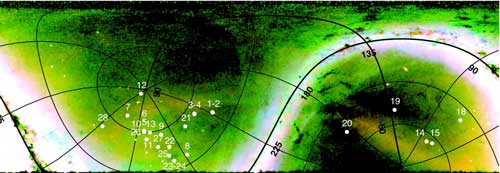| Jan 31, 2018 |
Galaxies that feed on other galaxies
|
|
(Nanowerk News) Most of the information we have about the Milky Way stellar halo comes from its inner region, which we can observe close to the solar neighbourhood. However, for the first time the chemical properties of the external regions of the halo of our galaxy were explored with high resolution spectroscopy in the optical of a sample of 28 red giant stars at large distances from the Sun.
|
|
The method that was used, i.e. a spectroscopic analysis, consists in separating the light of the stars in its different frequencies in order to obtain information on the star's chemical composition.
|
|
The analysis of the chemical properties of the stars can provide information on the characteristics of the environment in which they were born.
|
 |
| Distant Milky Way halo giants marked on a Pan-STARRS1 map. Location of our targets overlaid on a RGB rendering of the distribution of Milky Way halo stars. (Image: Giuseppina Battaglia) (click on image to enlarge)
|
|
"The abundance of some chemical elements in the stars in the external regions of the Milky Way halo - explains Giuseppina Battaglia, astrophysicist at the IAC and first author of the article (Astronomy & Astrophysics, "What is the Milky Way outer halo made of?") - was found to be surprisingly different from the information we had concerning the inner regions of the halo". On the other hand, several similarities were discovered with the chemical composition observed for stars in nearby massive dwarf galaxies, such as Sagittarius and the Large Magellanic Cloud. These signatures tells us that the external regions of the stellar halo might contain the remains of one, or more, massive dwarf galaxy, devoured by the Milky Way.
|
|
Stellar haloes are a common component of galaxies like the Milky Way. "The theory explaining the formation of structure and galaxies in the Universe predicts that stellar haloes, and in particular their outer regions, consist mainly of the stellar component of destroyed, smaller galaxies." G.Battaglia comments "Qualitatively this is in agreement with the observational findings of this study, where we found remnants of cannibalized dwarf galaxies around the Milky Way."
|
|
For this study data from about 100 hours of telescope observing time were used, obtained on facilities in both the Northern and Southern hemisphere. Specifically, the team used the Very Large Telescope "Kueyen" (UT2) of the European Southern Observatory in Paranal and the Magellan telescope Clay in Las Campanas, both in Chile, as well as the Hobby Eberly Telescope, in Texas.
|

